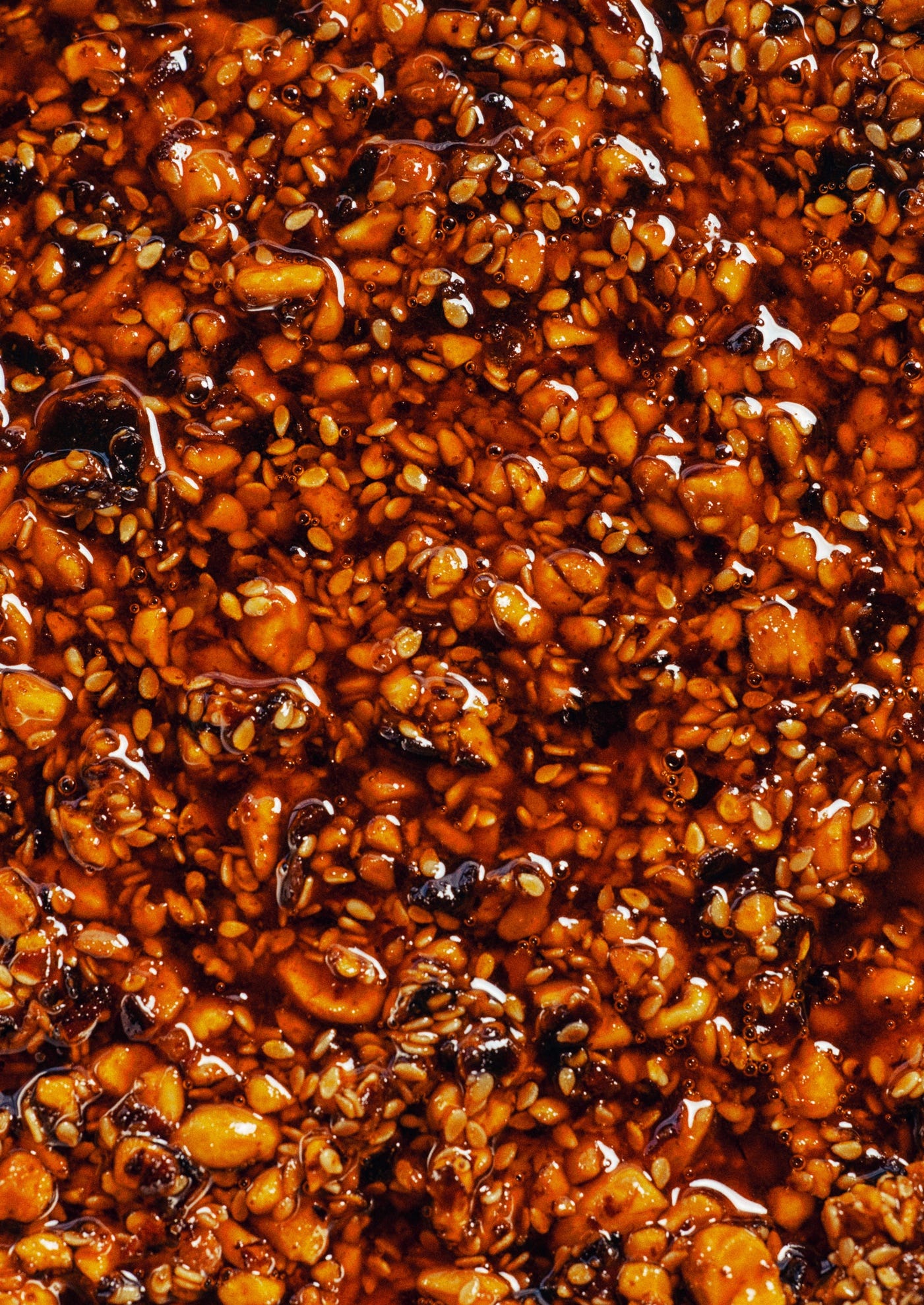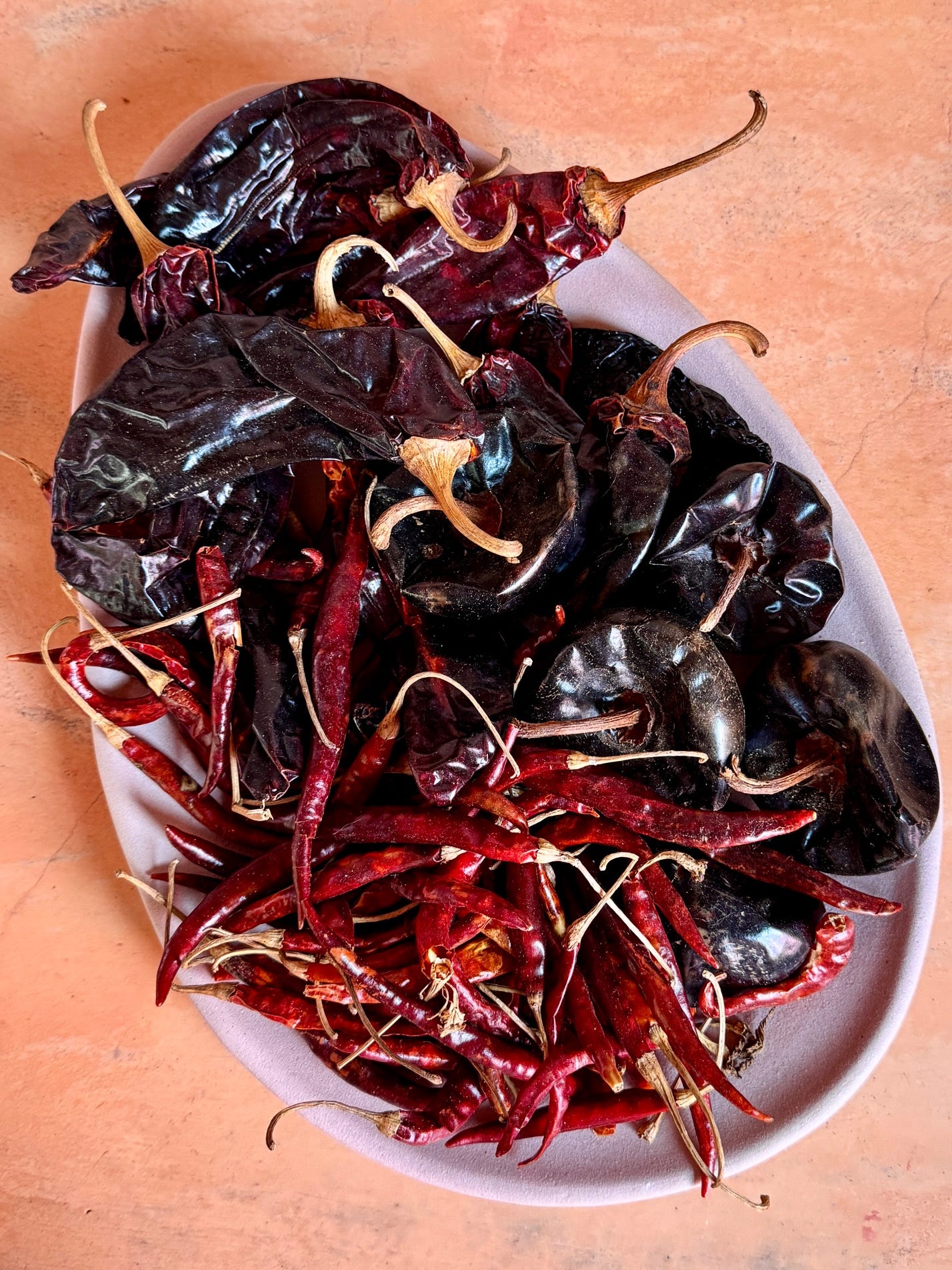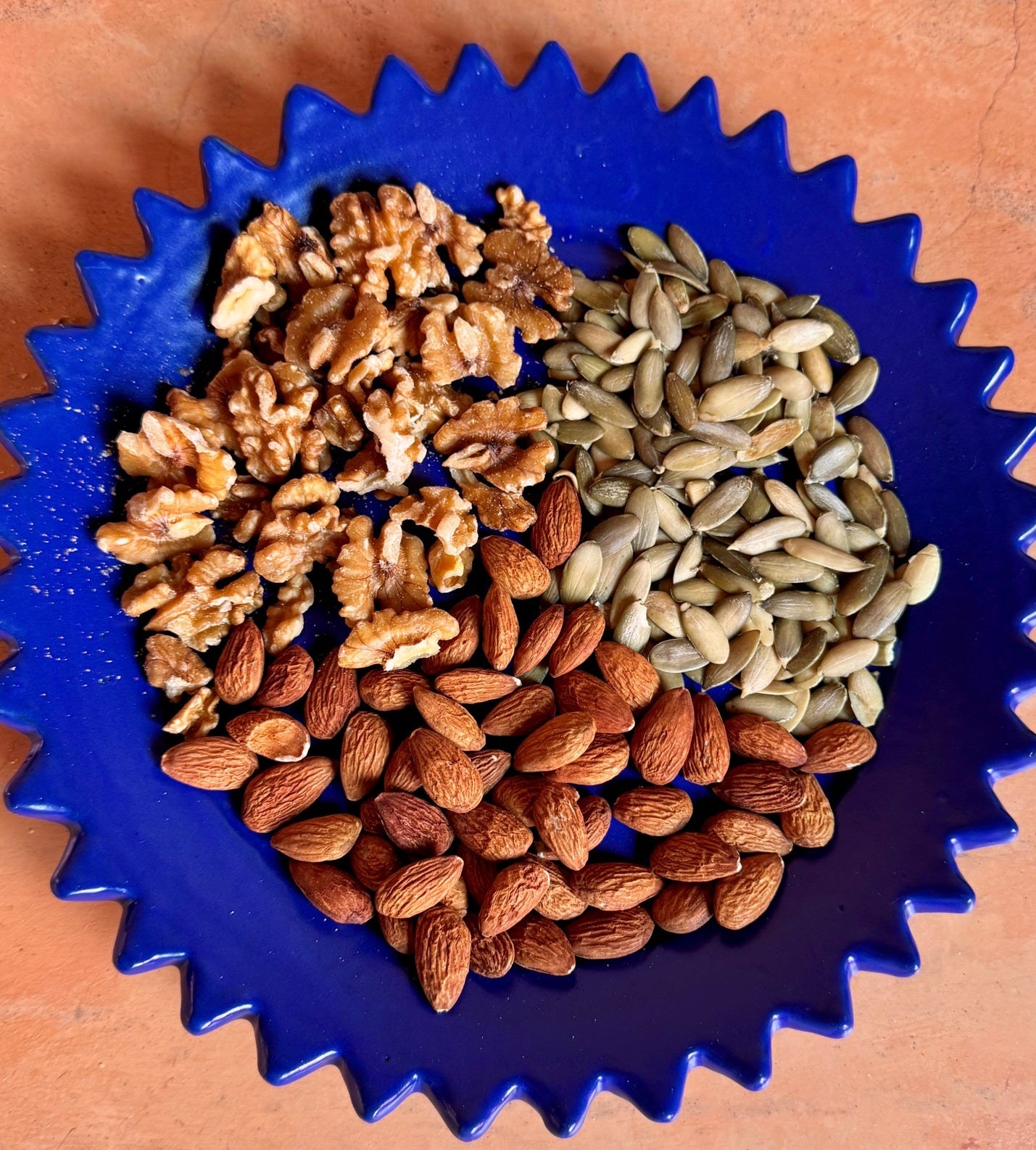TL;DR – What’s Inside
In Part 1, we traced salsa macha’s roots — from a dry chile paste in Veracruz to the rich, spoonable chile oil that lives in our fridges today.
This post is your how-to. You’ll learn:
The core building blocks: chiles, oil, nuts, seeds, and aromatics
My step-by-step toasting method (sweet garlic, never bitter)
How to riff with confidence — think pickled chiles, dried fruit, warm spices, even vanilla bean
Whether you want to go classic or get a little wild, this will help you build a salsa macha that’s bold, balanced, and completely yours.
👉 Missed Part 1? Start here: Why Salsa Macha Deserves a Spot in Your Fridge Forever
Building a Traditional Salsa Macha (Then Making It Yours)
At its core, salsa macha is made of four things: dried chiles, oil, nuts and seeds, and aromatics. Traditional versions from Veracruz and Oaxaca are bold, minimal, and efficient. You toast everything until it’s golden and fragrant, then blend and submerge it in oil. That’s it.
But like most great Mexican condiments, it invites adaptation — so once you learn the basics, I’ll show you how to get playful.
Chiles: The Soul of the Salsa
Start by choosing a base chile that brings flavor, not just heat. Then, if you want to turn up the spice, add a second or third one for kick.
Guajillo is earthy and citrusy, ancho brings a deep sweetness, and pasilla leans dark and a little bitter, like toasted cacao nibs. For heat, chile de árbol is clean and sharp, chiltepin is bright and wild, and morita adds smokiness with a little body.
Each one brings something different. My rule of thumb: one or two chiles for depth, one for heat.
Oil: The Vehicle and the Voice
Oil doesn’t just carry flavor — it becomes the flavor. In salsa macha, it’s the difference between something good and something unforgettable. The oil you choose shapes everything: the taste, the texture, how well it toasts, how long it keeps.
Start neutral. Traditional salsa machas are usually made with canola, vegetable, or grapeseed oil — clean, high-smoke-point oils that won’t fight your chiles and spices. They’re especially helpful if it’s your first time, because you can learn the timing of frying and toasting without worrying about burning or bitterness.
Once you’re confident, start playing.
Ghee lovers, this is your moment. Ghee has a high smoke point and a rich, mellow depth that leans nutty and warm. You can use 100% ghee — especially in dessert-adjacent salsas, like the ghee-vanilla one in Salsa Daddy.
What about flavorful oils?
Extra-virgin olive, toasted sesame, peanut, or coconut oils are tempting, but they’re loud. They can turn bitter when heated or overpower the balance. If you want their flavor, stir them in after cooking. That way, you get the best of both worlds: structure and soul.
My tip: save the fancy oil for the finish line. You wouldn’t fry onions in your best cold-pressed olive oil — same rule here.
And don’t be stingy. If you love that glossy red drizzle on tacos or beans, double down. Most recipes call for enough oil to blend and coat — but I like to add extra. A few days in, the solids are still there, but you’ll be using the oil to spoon over veggies and fish, and before you know it, it’s gone. Never fear — just top it off with more oil (even weeks later) and it will re-infuse with flavor.
What else can you do with that chile oil? Fry an egg. Dress roasted vegetables. Stir into rice. Drizzle on popcorn or over grilled fish. Make a vinaigrette. The oil is just as valuable as the solids. Make more. Use more. Enjoy more.
Nuts & Seeds: The Crunch Factor
This is where salsa macha gets its texture, its body, and that roasty-toasty richness that lingers long after the first bite. Think of nuts and seeds as the bassline — what keeps the salsa grounded and in rhythm.
Peanuts are a traditional anchor. They’re affordable, naturally sweet, and perfectly fatty. But don’t stop there. Cashews, pecans, almonds, walnuts, pepitas, sunflower seeds, sesame — they all work. If you’d happily snack on it plain, it will probably shine here too.
A little structure helps:
Keep it to two or three kinds. That’s enough for contrast without muddying the flavor. Unless you’ve got a bag of mixed nuts to use up — then go wild.
Here’s a move I love: taste your combo before you toast. Grab a nut and a few seeds and eat them raw, together. Does anything feel off? Is one too sharp or dominant? If it sings now, it will only get better once it’s been kissed with chile oil. You’re not just cooking. You’re composing.
How to Toast (My Way)
This is the magic moment. Toasting doesn’t just brown your ingredients — it wakes them up, infuses the oil, and brings that signature salsa macha warmth to life.
Here’s how I do it:
Start with cold neutral oil in a pot, and add your garlic and your largest nuts — like peanuts or almonds — while the oil is still cold. Then turn the heat to medium and let everything warm up together. This gentle approach gives you deeply golden garlic and perfectly toasted nuts without burning. You’ll know it’s ready when the garlic is golden outside, soft inside, and your kitchen smells like roasted heaven.
Scoop out the garlic and nuts with a slotted spoon and set them aside.
Now, drop in your stemmed and seeded chiles. These only need 10–15 seconds. Watch closely — they’ll darken, crisp up, and bloom with fragrance. Pull them out just before they tip into bitter.
Turn off the heat, move the pot off the burner, and stir in your seeds. The leftover heat is perfect for gently toasting sesame or sunflower seeds without scorching.
Then, pulse the solids — garlic, nuts, chiles — to your desired texture: chunky, coarse, or smooth. Pour in the oil and seeds and stir.
That’s it. You’ll know you nailed it when your kitchen smells incredible and every bite of whatever you’re eating suddenly needs just a little more macha.
Trust your palate. Toast with purpose. Taste as you go. You’re not just making salsa — you’re building flavor and joy.
Aromatics & Add-Ins: Your Signature Moves
Traditionally, garlic is the only aromatic in a classic salsa macha. And there’s a reason. When you toast it slowly, it turns sweet and savory, soft in the middle, golden at the edges. It gives the salsa body and warmth without demanding attention.
But once you’ve made a traditional batch, you might want to make it your own. That’s where the extras come in.
Shallots? Yes. Onions? Not so much.
Raw onions are too wet, too strong, and don’t cook down easily in oil. But thin crispy shallots — or golden fried onions — are excellent. Fry them separately, then fold them in at the end to keep that light, crunchy texture. You can also infuse the oil with raw shallots, like you do with garlic — just pull them before blending.
Pickled chiles and brine? Stir them in warm.
Chop the chiles fine and add them once the salsa is off the heat. A spoonful of brine brightens everything, adds zing, and cuts the richness. It’s a finishing move, not a cooking step.
Dried fruit? Absolutely.
Think raisins, cranberries, apricots, dates, mango, or pineapple — chopped small and stirred in at the end. The residual heat softens them and coaxes out their sweetness. They melt into the oil, adding body without overpowering.
Warm spices? Go easy.
Whole spices like cinnamon sticks or clove can be tossed into the hot oil at the end, then fished out before blending. Seeds like fennel can be toasted with the nuts and left for flavor and crunch. If you’re using ground spices, add just a pinch while the salsa is still warm. Cinnamon, clove, cardamom, black pepper — they all work, but only in whisper-level amounts. You’re seasoning, not making chai.
Skip the cocoa powder. It muddies the flavor.
Vanilla bean? Trust me.
Scrape the seeds from a pod and stir them in at the end — or drop the pod into the oil to infuse briefly. It adds floral sweetness that pairs beautifully with ghee, pecans, or dried fruit. And if you’re feeling festive: try it over vanilla ice cream. Yes, really.
The Rule of Thumb
If it’s crispy or dry, you can fry it or stir it in.
If it’s wet or sharp, stir it in at the end.
If you’re unsure, taste it raw and then with a spoonful of oil. Let your mouth decide.
Balance matters. You want to add character, not clutter. Keep the chiles front and center. Let everything else support them. And always — always — taste before you commit.
That’s a Wrap (For Now)
If you made it this far, your kitchen probably smells like toasted garlic and your fingers are itching to tear open some chiles. Salsa macha is one of those beautiful, forgiving salsas that gets better the more you make it — and the more you make it yours.
👉 Missed Part 1? Catch up here: Why Salsa Macha Deserves a Spot in Your Fridge Forever
Let’s Keep This Going
What’s your dream combo?
Guajillo and garlic? Morita and dried mango? Ghee, vanilla bean, and pecans? Drop your version in the comments — I’m always collecting inspiration (and I’ll try a few).
Made a batch?
Tag me or reply with a photo. I’ll be featuring some reader riffs in an upcoming post.
What’s Next
Part 3 – The Recipes
In the final post of this Salsa Macha mini-series, I’ll share two recipes:
A traditional version built around guajillo, peanut, and garlic.
A fully “Rickified” version with ghee and vanilla bean.
Want more salsa inspiration? Order Salsa Daddy. You’ll find traditional machas, playful spins with ghee and vanilla, and countless other salsas to spoon on everything from tacos to grilled vegetables.
🌶️ Loving Salsa School? Subscribe to Sazón so you don’t miss a lesson. Here’s how it works:
Free subscribers get the first five Salsa Schools (Roja, Verde, Guacamole, Macha, Hot Sauce), plus access to the 100 recipes already in the index and weekly posts.
Paid subscribers get all new weekly recipes, all future Salsa Schools and guides (beyond the first five), and deeper dives into Mexican cooking.
Both are great. Paid is better.









